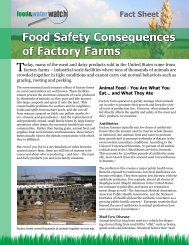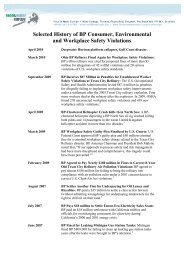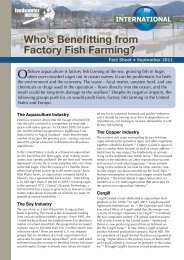How New York State Exaggerated Potential Job Creation from Shale ...
How New York State Exaggerated Potential Job Creation from Shale ...
How New York State Exaggerated Potential Job Creation from Shale ...
You also want an ePaper? Increase the reach of your titles
YUMPU automatically turns print PDFs into web optimized ePapers that Google loves.
Additional failures of <strong>New</strong> <strong>York</strong>’s<br />
analysis of socioeconomic impacts<br />
The “average” development scenario would rapidly<br />
expand drilling and fracking<br />
The “average” scenario assumed that 165 new wells<br />
would be drilled and fracked in the first year of development,<br />
increasing gradually to 1,652 new wells<br />
in the tenth year of development (see Table 1), after<br />
which point the annual number of new wells would<br />
stay at 1,652. For comparison, in Pennsylvania in<br />
2010 there were 1,405 new wells developed, and 2,459<br />
new wells have been projected for development in year<br />
2015. 38 <strong>New</strong> <strong>York</strong>’s rapid pace of shale gas development<br />
would be concentrated in certain counties, 39 and<br />
it is far <strong>from</strong> certain that such development could be<br />
sustained for 30 years.<br />
The <strong>New</strong> <strong>York</strong> analysis assumes that 50 percent of<br />
the wells would be located in just three counties:<br />
Broome, Chemung and Tioga. 40 Under the “average”<br />
development scenario, the number of new wells would<br />
increase gradually until reaching 826 new wells per<br />
year in years 10 through 30 in these three counties. 41<br />
In total, 21,067 wells would be developed in these<br />
three counties. 42<br />
With such extensive shale gas development, significant<br />
negative impacts on other parts of the economy,<br />
such as agriculture and tourism, would likely result,<br />
but the <strong>New</strong> <strong>York</strong> analysis fails to account for such<br />
negative impacts.<br />
Negative impacts on employment in agriculture and<br />
tourism <strong>from</strong> shale gas development are dismissed<br />
with a spurious argument<br />
Although the <strong>New</strong> <strong>York</strong> analysis acknowledges that<br />
shale gas development could have negative impacts on<br />
employment in other industries, these potential negative<br />
impacts are not included in the job projections. 43<br />
Instead, the <strong>New</strong> <strong>York</strong> analysis dismisses the significance<br />
of such negative impacts with the simple argument<br />
that “Cattaraugus and Chautauqua Counties<br />
still have healthy tourism sectors despite having more<br />
than 3,900 active natural gas wells in the region.” 44<br />
But the fact that tourism and agriculture exist as industries<br />
in Chautauqua and Cattaraugus counties is<br />
not a serious argument. It is quite possible that tourism<br />
would have been greater in these counties were<br />
it not for the past and current gas drilling. Moreover,<br />
modern shale gas development is far more intensive<br />
than conventional natural gas development: much longer<br />
boreholes drilled, much more fracking fluid used,<br />
much more wastewater created and much more heavyduty<br />
truck traffic. 45<br />
The cumulative impacts that such development would<br />
have on other parts of rural economies may be difficult<br />
to quantify, but they must not be dismissed.<br />
Thirty years of shale gas production per well is optimistic,<br />
meaning production jobs are likely overstated<br />
In projecting production phase jobs, the <strong>New</strong> <strong>York</strong><br />
analysis assumed that each new well produces shale<br />
gas for 30 years, and further assumed that the estimate<br />
of 0.17 FTE production phase workers per well<br />
would hold for all 30 years. 46 But this estimate, taken<br />
<strong>from</strong> the 2009 MSETC report, is based on only a few<br />
years of shale gas production in Pennsylvania. 47 This<br />
introduces significant uncertainty into <strong>New</strong> <strong>York</strong>’s<br />
production phase job projection. <strong>New</strong> <strong>York</strong> assumes<br />
that production of a typical horizontal well will fall by<br />
75 percent <strong>from</strong> year 1 to year 4, and by 90 percent<br />
by year 15. 48 But if production falls more rapidly than<br />
expected, then there would be fewer production phase<br />
jobs over the long term. Indeed, the U.S. Securities<br />
and Exchange Commission is investigating whether<br />
shale gas companies have overstated the productivity<br />
of shale gas wells. 49<br />
Rapidly changing estimates of the amount of recoverable<br />
shale gas also raise questions about future well<br />
productivity, 50 suggesting that the amount of gas that<br />
can be recovered <strong>from</strong> a given location of the shale<br />
may vary significantly <strong>from</strong> well to well.<br />
8 Food & Water Watch • www.foodandwaterwatch.org
















